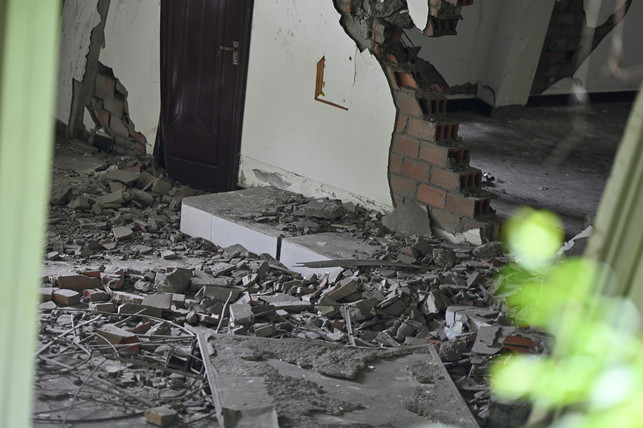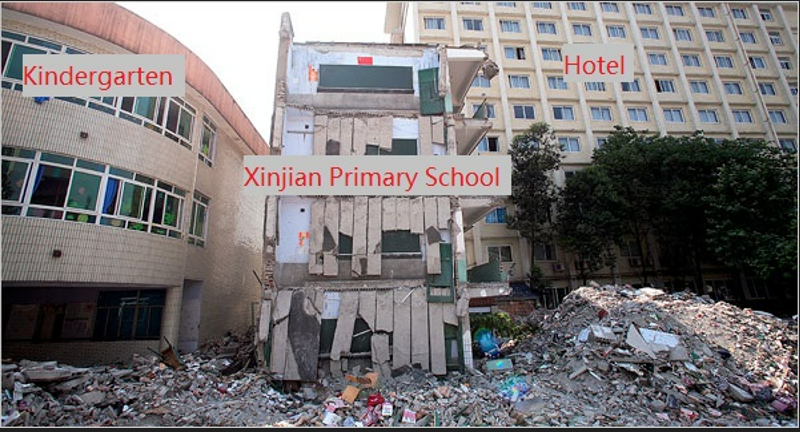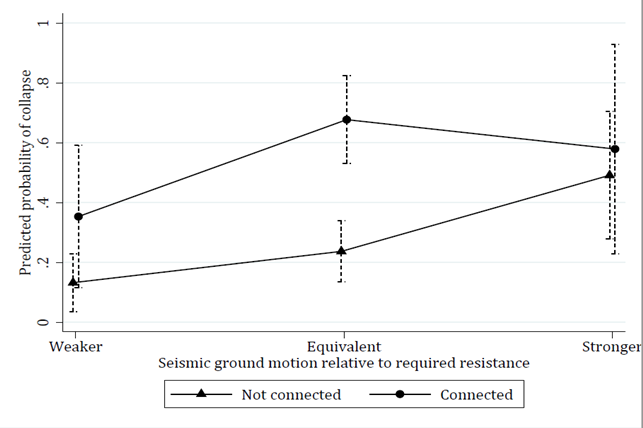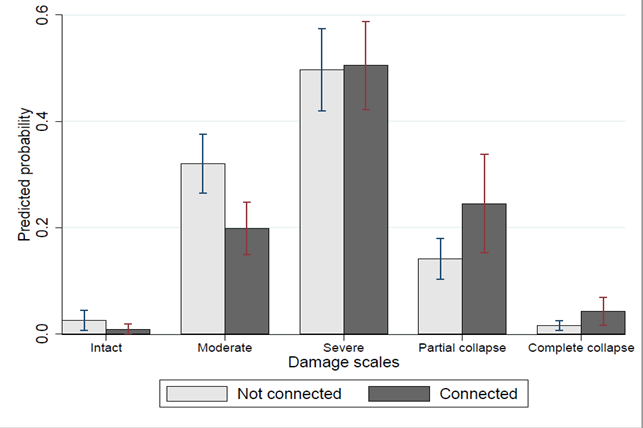Connections and Buildings collapse in the Sichuan Earthquake
This study investigates the factors contributing to building damage during the 2008 Sichuan earthquake. Utilizing a unique dataset covering 1,065 buildings in the affected area, the author demonstrates that buildings constructed during periods when county officials had patronage connections to their supervisors (based on hometown ties) are 83% more likely to collapse compared to those without such connections. Further analysis indicates that weaker enforcement of building codes is likely the primary reason for this difference. The findings uncover the hidden vulnerability created by a weak institutional environment and emphasize the significance of institutional factors in determining the outcomes of adverse events.

Growing concerns have emerged regarding the heightened vulnerability to earthquakes and other natural disasters often attributed to corruption and deficiencies in institutional environments. A striking example is the 7.8-magnitude earthquake that devastated southern Turkey and northern Syria on February 6, 2023. The disaster claimed tens of thousands of lives, leveled vast urban areas, and plunged the region into chaos. The catastrophe's severity is believed to have been exacerbated by corruption and inadequate enforcement of building codes.
The problem of heightened vulnerability transcends low-income countries and earthquakes. The US experienced similar challenges in 2005 during Hurricane Katrina, leading to over 1,200 deaths and infrastructure damage. The 2017 Grenfell Tower fire in London, which was linked to regulatory and oversight failures, further underscores the critical role institutions play in reducing disaster impacts. These instances highlight the importance of examining the factors that contribute to societal vulnerabilities and emphasize the need for strong institutional environments.
For years, researchers have stressed the need to investigate the role of institutional factors in disaster vulnerability, urging cooperation between natural and social scientists (O’Keefe, Westgate, and Wisner 1976; Adger et al. 2005; McNutt 2015; Eakin et al. 2017). Cross-country studies have revealed a connection between increased disaster death tolls and weaker institutions, characterized by restricted democratic practices and rampant corruption (Kahn 2005; Escaleras, Anbarci, and Register 2007; Ambraseys and Bilham 2011). However, the specific mechanisms driving this relationship at a more granular level remain unclear, despite numerous rumors and anecdotal evidence.
In a recent study by Cao (2023), the author examines the influence of institutional factors on disaster outcomes, using the 2008 Sichuan earthquake as a case study. This earthquake was one of the most catastrophic events in modern history, resulting in 87,587 fatalities. In the aftermath, many anecdotal accounts emerged suggesting that substandard construction may have contributed to the high death rate. For example, a photo published in the New York Times (Figure 1) showed a completely destroyed primary school, while two adjacent buildings had relatively minimal damage (Yardley 2008). Post-earthquake surveys also revealed that many collapsed buildings lacked reinforcing materials in their columns and had little seismic resistance, ductility, or redundancy. These inadequacies are often attributed to poor enforcement of relevant building codes, but until now, there has been no systematic evidence to confirm this connection.

Xinjian Primary School in Dujiangyan was destroyed, while a kindergarten, at left, and a hotel were barely damaged (Yardley 2008).
Photo Du Bin, The New York Times
Cao (2023) analyzed data on 1,065 buildings impacted by the earthquake, including location, construction year, and damage level based on official seismic surveys rated on a five-point scale (1 = intact, 5 = fully collapsed). The author collected information on county leadership during each building’s construction year, focusing on hometown connections between top county officials and their higher-level supervisors. These connections influence official selection, resource allocation, and government accountability, often resulting in less effective administration, weaker law enforcement, and increased corruption in areas governed by connected officials.
The research shows that hometown connections of county officials during a building’s construction can predict the extent of earthquake damage. Specifically, the likelihood of partial or full collapse increases by 13 percentage points (83%) when a building was constructed under connected officials (Figure 2). However, buildings built just before the county started having connected officials show no increased vulnerability, suggesting that the worsened damage is likely due to the connected officials’ influence.

The figure depicts the predictive margins of hometown ties derived from an ordinal-probit estimation. Each bar represents the predicted probability for each of the damage scales a building would have experienced with and without a connected official when constructed. The regression considers account county fixed effects, year fixed effects, building type by year fixed effects, building features, and geographic controls. Standard errors are clustered by county.
The study further investigates why county officials’ hometown connections led to more severe building damage during the earthquake. Four pieces of evidence suggest that insufficient building code enforcement by the government may be the cause:
• Hometown connections mainly matter for buildings in moderately affected regions, where seismic intensity matches resistance requirements (Figure 3). These buildings should have survived, but suffered greater than expected damage, a pattern often indicative of corner-cutting and code violations.
• The negative consequences are mostly observed for officials directly responsible for public administration and legal enforcement (i.e., governors) rather than those with more political authority to set agendas (i.e., party secretaries), implying that poor government enforcement may have contributed to noncompliance.
• The effects are mainly found in schools and hospitals, while government headquarters, where officials themselves stay, appear unaffected. This suggests that connected officials enforced building codes effectively when they internalized the costs and benefits of building safety.
• Private enforcement, indicated by private investment or donations, helps mitigate or even offset the negative consequences of having connected officials.
Although no single piece of evidence is conclusive, taken together, they suggest that hometown connections may have led to weaker institutional enforcement, possibly due to shirking or corruption by connected officials.

The figure depicts the predictive margins of patronage ties, by seismic groups, derived from a probit estimation in which the outcome is an indicator of building collapse. The sample contains 1,065 buildings in the linked sample. The scatters and connected lines represent the predicted probability of collapse for buildings suffering from ground motion weaker than, equivalent to, and stronger than the seismic resistance requirements, respectively. The regression considers county fixed effects, year fixed effects, building type by year fixed effects, building features, and geographic controls. Standard errors are clustered by county.
The author also explores the economic relevance of the findings by analyzing county-level aggregates, examining economically significant outcomes across all 181 counties in Sichuan Province. The study documents a positive cross-county correlation between earthquake losses and the duration of county officials’ connectedness: one additional year with a connected official is associated with an 8% increase in mortality and a 3% increase in direct economic loss from the earthquake. This pattern is observed across all sectors except for government agencies.
This study offers valuable insights into institutional performance and the impacts of natural shocks. It provides causal evidence that institutional failures can create societal vulnerability, amplifying damage from adverse events. Additionally, it highlights that the frailty of institutions may become apparent only after those institutions fail under stress. Though the study focuses on a natural disaster in China, its implications are likely applicable to other economic realms and countries.
References
Adger, W. Neil, Terry P. Hughes, Carl Folke, Stephen R. Carpenter, and Johan Rockström. 2005. “Social-Ecological Resilience to Coastal Disasters.” Science 309 (5737): 1036–39. https://doi.org/10.1126/science.1112122.
Ambraseys, Nicholas, and Roger Bilham. 2011. “Corruption Kills.” Nature 469 (7329): 153–55. https://doi.org/10.1038/469153a.
Cao, Yiming. 2023. “Institutional Weakness and Societal Vulnerability: Evidence from the Sichuan Earthquake.” Working Paper. Chttps://conference.nber.org/conf_papers/f176994.pdf.
Eakin, Hallie, Luis A. Bojórquez-Tapia, Marco A. Janssen, Matei Georgescu, David Manuel-Navarrete, Enrique R. Vivoni, Ana E. Escalante, Andres Baeza-Castro, M. Mazari-Hiriart, and Amy M. Lerner. 2017. “Opinion: Urban Resilience Efforts Must Consider Social and Political Forces.” Proceedings of the National Academy of Sciences of the United States of America 114 (2): 186–89. https://doi.org/10.1073/pnas.1620081114.
Escaleras, Monica, Nejat Anbarci, and Charles A. Register. 2007. “Public Sector Corruption and Major Earthquakes: A Potentially Deadly Interaction.” Public Choice 132: 209–30. https://doi.org/10.1007/s11127-007-9148-y.
Kahn, Matthew E. 2005. “The Death Toll from Natural Disasters: The Role of Income, Geography, and Institutions.” Review of Economics and Statistics 87 (2): 271–84. https://www.jstor.org/stable/40042902.
McNutt, Marcia. 2015. “A Community for Disaster Science.” Science 348 (6230): 11. https://doi.org/10.1126/science.aab2091.
O’Keefe, Phil, Ken Westgate, and Ben Wisner. 1976. “Taking the Naturalness Out of Natural Disasters.” Nature 260: 566–67. https://doi.org/10.1038/260566a0.
Yardley, Jim. 2008. “Chinese Are Left to Ask Why Schools Crumbled.” New York Times, May 25, 2008. https://www.nytimes.com/2008/05/25/world/asia/25schools.html.

Latest
Most Popular
- VoxChina Covid-19 Forum (Second Edition): China’s Post-Lockdown Economic Recovery VoxChina, Apr 18, 2020
- China’s Great Housing Boom Kaiji Chen, Yi Wen, Oct 11, 2017
- China’s Joint Venture Policy and the International Transfer of Technology Kun Jiang, Wolfgang Keller, Larry D. Qiu, William Ridley, Feb 06, 2019
- The Dark Side of the Chinese Fiscal Stimulus: Evidence from Local Government Debt Yi Huang, Marco Pagano, Ugo Panizza, Jun 28, 2017
- Wealth Redistribution in the Chinese Stock Market: the Role of Bubbles and Crashes Li An, Jiangze Bian, Dong Lou, Donghui Shi, Jul 01, 2020
- What Is Special about China’s Housing Boom? Edward L. Glaeser, Wei Huang, Yueran Ma, Andrei Shleifer, Jun 20, 2017
- Privatization and Productivity in China Yuyu Chen, Mitsuru Igami, Masayuki Sawada, Mo Xiao, Jan 31, 2018
- Evaluating Risk across Chinese Housing Markets Yongheng Deng, Joseph Gyourko, Jing Wu, Aug 02, 2017
- How did China Move Up the Global Value Chains? Hiau Looi Kee, Heiwai Tang, Aug 30, 2017
- China’s Shadow Banking Sector: Wealth Management Products and Issuing Banks Viral V. Acharya, Jun Qian, Zhishu Yang, Aug 09, 2017




 Facebook
Facebook  Twitter
Twitter  Instagram
Instagram WeChat
WeChat  Email
Email 


